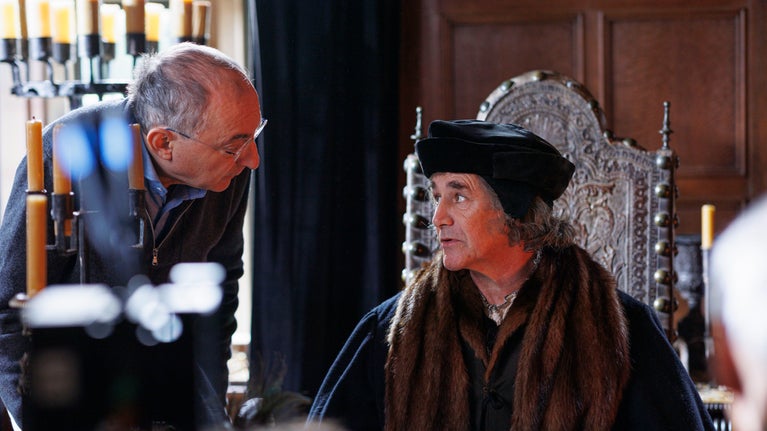
Stars of the screen
Find out which historic houses and dramatic landscapes you can see on-screen, from popular TV dramas to brand new films.

Based on the bestselling trilogy by author Hilary Mantel, the BBC drama series Wolf Hall traces Thomas Cromwell’s swift rise from a blacksmith’s son in Putney to the most powerful man in King Henry VIII’s Tudor court. Many of the places in our care were used as filming locations for both the original 2015 series and the 2024 adaptation of the final novel in the trilogy, The Mirror and the Light.
Montacute House returns as Greenwich Palace, Henry VIII’s main London seat and the site of Anne Boleyn’s arrest in Wolf Hall. In the first series, the Elizabethan mansion’s extensive grounds provided a spectacular backdrop to jousting scenes and hosted the dazzling Royal tent. In the Mirror and the Light, Montacute’s 15th-century tapestries frame an ageing, gout-ridden Henry VIII (Damian Lewis).
Great Chalfield Manor, a moated manor house that was built between 1465 and 1480 for Thomas Tropenell, once again stood in for Austin Friars, Thomas Cromwell’s (Mark Rylance) home. It's portrayed as a happy place teeming with in-laws and wards, nieces and nephews and painters.
Grade I-listed manor house Horton Court, now a holiday cottage, returns as Cromwell's study at Austin Friars.
Sitting on the edge of the rolling Cotswolds, the 16th-century manor house was built from the remains of a Norman hall.
Free from collections and furniture, the spacious interiors of Barrington Court were dressed in the drama to become York Place, the home of Cromwell’s mentor and friend Cardinal Wolsey.
Saved from ruin and restored by the Lyle family in the 1920s, the manor house features the wood-panelled Long Gallery, which, in Tudor times, would have provided a space for indoor exercise.
The exteriors of Lacock Abbey double as Wolf Hall, the Seymour family seat, in the TV series. Founded in the 13th century as an Augustinian nunnery, Henry VIII sold the abbey to one of his courtiers, Sir William Sharington, who converted it into a house following the dissolution of the monasteries.
The advantages of filming in a historic location are massive. It also helps the actors, if they’re stepping into the buildings that Henry VIII and Thomas Cromwell walked around in, it helps bring a realness to the project. The National Trust was very supportive, and around 40% of the overall shoot was at Trust places.
Chastleton’s small stone courtyard provided the location for the dramatic scenes from Cromwell’s miserable childhood in Putney.
Chastleton’s interiors represent Wolf Hall itself, the Seymour family seat. Built by a rich wool merchant between 1607 and 1612, the house has remained relatively unchanged for nearly 400 years.
Built for Lord Sandys, Henry VIII's Lord Chamberlain, the Vyne is mentioned in Wolf Hall during a conversation between Thomas Cromwell and Mary Tudor.
In the book, Cromwell tells Mary that her father the King intends to visit Lord Sandys to see his ‘handsome new gallery’, which remains the same as Henry VIII would have seen it hundreds of years ago.
Sutton House in Hackney was built in 1535 by Ralph Sadler, who rose to be a prominent member of Henry VIII’s court, and also served Edward VI and Elizabeth I.
Ralph Sadler is an important character in Wolf Hall (and its sequel Bring Up the Bodies), he joined Cromwell’s household as a child and later wed his wife Helen Barre, who worked as a laundress for the family.
As well as showing off beautiful locations, filming directly benefits the places that star in the production. The income from location fees goes straight back into conservation work to care for historic houses and landscapes, so that we’ll all be able to see them both on screen and in real life for years to come.

Find out which historic houses and dramatic landscapes you can see on-screen, from popular TV dramas to brand new films.

Fancy taking a break somewhere you've seen on screen? From The Secret Garden to Game of Thrones and Harry Potter, many of the places we care for have been filming locations for much-loved movies and TV shows.

An atmospheric fragment of old Somerset; the estate is the vision of Colonel Lyle and his architect James Edwin Forbes. Whilst Court House remains closed for repair, the ground floor of Strode House is open, and there are glorious garden rooms, avenues, and orchards to explore. Installations in the farm buildings tell the stories of key characters and the development of the estate.

A masterpiece of Elizabethan Renaissance architecture and design, with towering walls of glass, glowing ham stone and surrounding garden. While the upper floors of the house will remain closed for 2025 there is plenty to see on the ground floor, and in the garden and parkland.

Country house with monastic roots, once home to William Henry Fox Talbot, inventor of the photographic negative

Charming fifteenth-century manor house with Arts and Crafts garden

Discover the myths and memories of an ancient country house, a compelling time capsule of 400 years of family life